An Open Integrated Rock Spectral Library (RockSL) for a Global Sharing and Matching Service
Abstract
:1. Introduction
2. Materials
2.1. Data Sources
2.1.1. Shared Spectral Libraries
2.1.2. Field Sampling Data
3. Methods and Key Technologies
3.1. Processing Workflow
3.2. Data Acquisition and Transformation
3.2.1. Data Acquisition
3.2.2. Data Transformation
3.3. Quality Control
- (1)
- Spectral correlation coefficient [44]. This coefficient is used to fit the two reflectivity curves on the basis of the principle of least squares. The formula of the correlation coefficient is as follows:where is the correlation coefficient between the reference spectrum and target spectrum , is the covariance of the reference and matched target spectra, is the reference spectral variance, and is the matched target spectral variance.
- (2)
- Angle cosine [45]. The value represents the generalised included angle of two target curves in n-dimensional space. The formula of angle cosine is as follows:where is the sample reflectance of the point of the ith curve, is the sample reflectance of the point of the jth curve, and is the number of sample points at the spectral curve.
3.4. Spectral Retrieve, Analysis, and Matching
4. Results and Experiment
4.1. Platform Development
4.2. Experimental Validation
4.2.1. FTIR Spectrometer
4.2.2. Experimental Analysis
5. Discussion and Conclusions
Author Contributions
Funding
Data Availability Statement
Acknowledgments
Conflicts of Interest
References
- Fang, Q.; Hong, H.; Zhao, L.; Kukolich, S.; Yin, K.; Wang, C. Visible and Near-Infrared Reflectance Spectroscopy for Investigating Soil Mineralogy: A Review. J. Spectrosc. 2018, 2018, 1–14. [Google Scholar] [CrossRef]
- Viscarra Rossel, R.A.; Behrens, T.; Ben-Dor, E.; Brown, D.J.; Demattê, J.A.M.; Shepherd, K.D.; Shi, Z.; Stenberg, B.; Stevens, A.; Adamchuk, V.; et al. A global spectral library to characterize the world’s soil. Earth Sci. Rev. 2016, 155, 198–230. [Google Scholar] [CrossRef] [Green Version]
- Tong, Q.; Zhang, B.; Zheng, L. Hyperspectral Remote Sensing: Principle, Technique and Application; Higher Education Press: Beijing, China, 2006. [Google Scholar]
- Magendran, T.; Sanjeevi, S. Hyperion image analysis and linear spectral unmixing to evaluate the grades of iron ores in parts of Noamundi Eastern India. Int. J. Appl. Earth Obs. Geoinform. 2014, 26, 413–426. [Google Scholar] [CrossRef]
- Dai, J.; Zhao, L.; Jiang, Q.; Wang, H.; Liu, T. Review of thermal-infrared spectroscopy applied in geological ore exploration. Acta Geol. Sin. 2020, 94, 8. [Google Scholar]
- Goetz, A.F.H. Spectroscopic Remote Sensing for Geological Applications. Imaging Spectrosc. I Int. Soc. Opt. Photonics 1981, 268, 17–21. [Google Scholar]
- Clark, R.N.; Swayze, G.A.; Livo, K.E.; Kokaly, R.F.; Sutley, S.J.; Dalton, J.B.; Gent, C.A. Imaging spectroscopy: Earth and planetary remote sensing with the usgs tetracorder and expert systems. J. Geophys. Res. Planets 2003, 108. [Google Scholar] [CrossRef]
- Meer, F.; Werff, H.; Ruitenbeek, F.; Hecker, C.A.; Bakker, W.H.; Noomen, M.F.; der Meijde, M.E.; Carranza, J.M.; de Smeth, B.J.; Woldai, T. Multi and hyperspectral geologic remote sensing: A review. Int. J. Appl. Earth Obs. Geoinform. 2012, 14, 112–128. [Google Scholar] [CrossRef]
- Zhang, Y.T.; Xiao, Q.; Wen, J.G.; You, D.Q.; Dou, B.C.; Tang, Y. Review on spectral libraries: Progress and application. J. Remote Sens. 2017, 21, 12–26. [Google Scholar] [CrossRef] [Green Version]
- Goetz, A.F.H.; Vane, G.; Solomon, J.E.; Rock, B.N. Imaging spectrometry for earth remote sensing. Science 1985, 228, 1147–1153. [Google Scholar] [CrossRef]
- Green, R.O.; Eastwood, M.L.; Sarture, C.M.; Chrien, T.G.; Aronsson, M.; Chippendale, B.J.; Williams, O. Imaging spectroscopy and the airborne visible/infrared imaging spectrometer (AVIRIS). Remote Sens. Environ. 1998, 65, 227–248. [Google Scholar] [CrossRef]
- Mulder, V.L.; de Bruin, S.; Weyermann, J.; Kokaly, R.F.; Schaepman, M.E. Characterizing regional soil mineral composition using spectroscopy and geostatistics. Remote Sens. Environ. 2013, 139, 415–429. [Google Scholar] [CrossRef]
- Cheng, J.; Xiao, Q.; Wen, J.; Tang, Y.; You, D.; Bian, Z.; Zhong, S. Review of Methods and Remote Sensing Cases Using Spectral Library. Remote Sens. Technol. Appl. 2020, 35, 267–286. [Google Scholar]
- Zhou, X.; Zhou, D. Review of digital ground object spectral library. Spectrosc. Spectr. Anal. 2009, 29, 1616–1622. [Google Scholar]
- Xie, B.S.; Zhou, S.Y.; Wu, L.X. An Integrated Mineral Spectral Library Using Shared Data for Hyperspectral Remote Sensing and Geological Mapping. Int. Arch. Photogramm. Remote Sens. Spat. Inf. Sci. 2020, 43, 69–75. [Google Scholar] [CrossRef]
- Leeman, V.; Dianne, G.; Earing, D.; Vincent, R.K.; Ladd, S. The NASA Earth Resources Spectral Information System: A Data Compilation; University of Michigan: Ann Arbor, MI, USA, 1971. [Google Scholar]
- Salisbury, J.W.; D’Aria, D.M. Emissivity of terrestrial materials in the 8–14 μm atmospheric window. Remote Sens. Environ. 1992, 42, 83–106. [Google Scholar] [CrossRef]
- Clark, R.N.; Swayze, G.A.; Gallagher, A.J.; King, T.V.V.; Calvin, W.M. The U.S. Geological Survey Digital Spectral Library: Version 1 (0.2 to 3.0μm) (No. 93-592); Geological Survey (US): Reston, VA, USA, 1993. [Google Scholar]
- Kokaly, R.F.; Clark, R.N.; Swayze, G.A.; Livo, K.E.; Hoefen, T.M.; Pearson, N.C.; Wise, R.A.; Benzel, W.M.; Low, H.A.; Driscoll, R.L.; et al. USGS Spectral Library Version 7 Data: U.S. Geological Survey Data Release; United States Geological Survey (USGS): Reston, VA, USA, 2017. [Google Scholar] [CrossRef]
- Gillespie, A.; Rokugawa, S.; Matsunaga, T.; Cothern, J.S.; Hook, S.; Kahle, A.B. A temperature and emissivity separation algorithm for Advanced Spaceborne Thermal Emission and Reflection Radiometer (ASTER) images. IEEE Trans. Geosci. Remote Sens. 1998, 36, 1113–1126. [Google Scholar] [CrossRef]
- Baldridge, A.M.; Hook, S.J.; Grove, C.I.; Rivera, G. The ASTER spectral library version 2.0. Remote Sens. Environ. 2009, 113, 711–715. [Google Scholar] [CrossRef]
- Zhang, B.; Wang, X.; Liu, J.; Zheng, L.; Tong, Q. Hyperspectral image processing and analysis system (HIPAS) and its applications. Photogramm. Eng. Remote Sens. 2000, 66, 605–609. [Google Scholar]
- Tong, Q.; Tian, G. Spectra and Analysis of Typical Earth Objects of China; Science Press: Beijing, China, 1990. [Google Scholar]
- Li, X.; Liu, S. Principle and Application of Remote Sensing; Science Press: Beijing, China, 2008. [Google Scholar]
- Su, L.; Li, X.; Wang, J.; Tang, S. Some Problems of Typical Ground Object Spectral Knowledge Base Construction and Spectral Service. Adv. Earth Sci. 2003, 2, 185–191. [Google Scholar]
- Zhong, S.Y.; Xiao, Q.; Wen, J.G.; Zhen, X.M.; Ma, M.G.; Qu, Y.H.; Zhao, L.J. Design and realization of ground object background spectral library for surveying and mapping. J. Remote Sens. 2020, 24, 701–716. [Google Scholar]
- Hueni, A.; Nieke, J.; Schopfer, J.; Kneubühler, M.; Itten, K.I. The Spectral Database SPECCHIO for Improved Long-Term Usability and Data Sharing. Comput. Geosci. 2009, 35, 557–565. [Google Scholar] [CrossRef] [Green Version]
- Landgrebe, D. On Information Extraction Principles for Hyperspectral Data; Purdue University: West Lafayette, IN, USA, 1997; p. 34. [Google Scholar]
- Kruse, F.A. Artificial Intelligence for Geologic Mapping with Imaging Spectrometers; Open File Report; 1993. Available online: https://ntrs.nasa.gov/citations/19930008790 (accessed on 2 December 2021).
- Kahle, A.B.; Goetz, A.F.H. A data base of geologic field spectra. In Proceedings of the 15th International symposium on Remote Sensing of Environment, Ann Arbor, MI, USA, 11 May 1981. [Google Scholar]
- Grove, C.I.; Hook, S.J.; Paylor II, E.D. Compilation of Laboratory Reflectance Spectra of 160 Minerals, 0.4 to 2.5 Micrometers; Jet Propulsion Laboratory, NASA: Washington, DC, USA, 1992. [Google Scholar]
- Peng, W.; Liu, G. Infrared Spectra of Minerals; Science Press: Beijing, China, 1982. [Google Scholar]
- Christensen, P.R.; Bandfield, J.L.; Hamilton, V.E.; Howard, D.A.; Lane, M.D.; Piatek, J.L.; Stefanov, W.L. A thermal emission spectral library of rock-forming minerals. J. Geophys. Res. 2000, 105, 9735–9739. [Google Scholar] [CrossRef] [Green Version]
- Lampinen, H.M.; Laukamp, C.; Occhipinti, S.A.; Hardy, L. Mineral Footprints of the Paleoproterozoic Sediment-Hosted Abra Pb-Zn-Cu-Au Deposit Capricorn Orogen, Western Australia. Ore Geol. Rev. 2019, 104, 436–461. [Google Scholar] [CrossRef]
- Pelkey, S.M.; Mustard, J.F.; Murchie, S.; Clancy, R.T.; Wolff, M.; Smith, M.; Gondet, B. CRISM multispectral summary products: Parameterizing mineral diversity on Mars from reflectance. J. Geophys. Res. Planets 2007, 112, 171–178. [Google Scholar] [CrossRef]
- Blanco-Cuaresma, S.; Soubiran, C.; Jofré, P.; Heiter, U. The Gaia FGK benchmark stars-High resolution spectral library. Astron. Astrophys. 2014, 566, A98. [Google Scholar] [CrossRef] [Green Version]
- Shanghai Institute of Organic Chemistry of CAS. Chemistry Database [DB/OL]. Available online: http://www.organchem.csdb.cn,1978-2020 (accessed on 16 December 2020).
- Wang, D.; Liu, S.J.; Mao, Y.C.; Wang, Y.; Li, T.Z. A method Based on Thermal Infrared Spectrum for Analysis of SiO2 Content in Anshan-Type Iron. Spectrosc. Spectr. Anal. 2016, 38, 2101–2106. [Google Scholar]
- Song, L.; Liu, S.J.; Yu, M.L.; Mao, Y.C.; Wu, L.X. A Classification Method Based on the Combination of Visble, Near-Infrared and Thermal Infrared Spectrum for Coal and Gangue Distinguishment. Spectrosc. Spectr. Anal. 2017, 37, 416–422. [Google Scholar]
- Xie, B.S.; Zhou, S.Y.; Wu, L.X.; Mao, W.F.; Wang, W. RockSL: An Integrated Rock Spectral Library for Better Global Shared Services. Big Earth Data 2021, 06. [Google Scholar] [CrossRef]
- Naccache, N.J.; Shinghal, R. An investigation into the skeletonization approach of Hilditch. Pattern Recognit. 1984, 17, 279–284. [Google Scholar] [CrossRef]
- Fu, Q.; Ni, S.; Guo, J.; Kai, L. Vectorization of Raster Data and Solving of it’s Problems. Geo Inf. Sci. 2004, 3, 8–11. [Google Scholar]
- Fan, J. Study on Construction and Implementation of Typical Ground Object Spectrum Database in Yanzhou Mining Area; Shandong University of Science and Technology: Qingdao, China, 2011. [Google Scholar]
- Mcglone, J.C.; Shufelt, J.A. Projective and Object Space Geometry for Monocular Building Extraction; Carnegie Mellon University: Pittsburgh, PA, USA, 1994. [Google Scholar]
- Kruse, F.A.; Lefkoff, A.B.; Boardman, J.W.; Heidebrecht, K.B.; Shapiro, A.T.; Barloon, P.J.; Goetz, A.F.H. The Spectral Image Processing System (SIPS) Software for Integrated Analysis of AVIRIS Data; Summaries of the 4th Annual JPL Airborne Geoscience Workshop; Pasadena JPL Pub: Pasadena, CA, USA, 1992; pp. 23–25. [Google Scholar]
- Pu, R.; Gong, P. Hyperspectral Remote Sensing and its Application; Higher Education Press: Beijing, China, 2000. [Google Scholar]
- Su, H.; Du, P.; Sheng, Y. Study on feature extraction and experiment of hyperspectral data. Remote Sens. Technol. Appl. 2008, 4, 288–293. [Google Scholar]
- Clark, R.N.; King, T.V. Automatic Continuum Analysis of Reflectance Spectra; NASA: Washington, DC, USA, 1987. [Google Scholar]
- Wang, J.; Zhen, L.; Tong, Q. The Spectral Absorption Identification Model and Mineral Mapping by Imaging Spectrometer Data. Remote Sens. Environ. China 1996, 1, 20–31. [Google Scholar]
- Jia, X.; Richards, A.J. Binary coding of imaging spectrometry data for fast Spectral matching and classification. Remote Sens. Environ. 1993, 43, 47–53. [Google Scholar] [CrossRef]
- Noronha, S.; Nevatia, R. Detection and Modeling of Buildings from Multiple Aerial Images. IEEE Trans. Pattern Anal. Mach. Intell. 2001, 23, 501–518. [Google Scholar] [CrossRef]

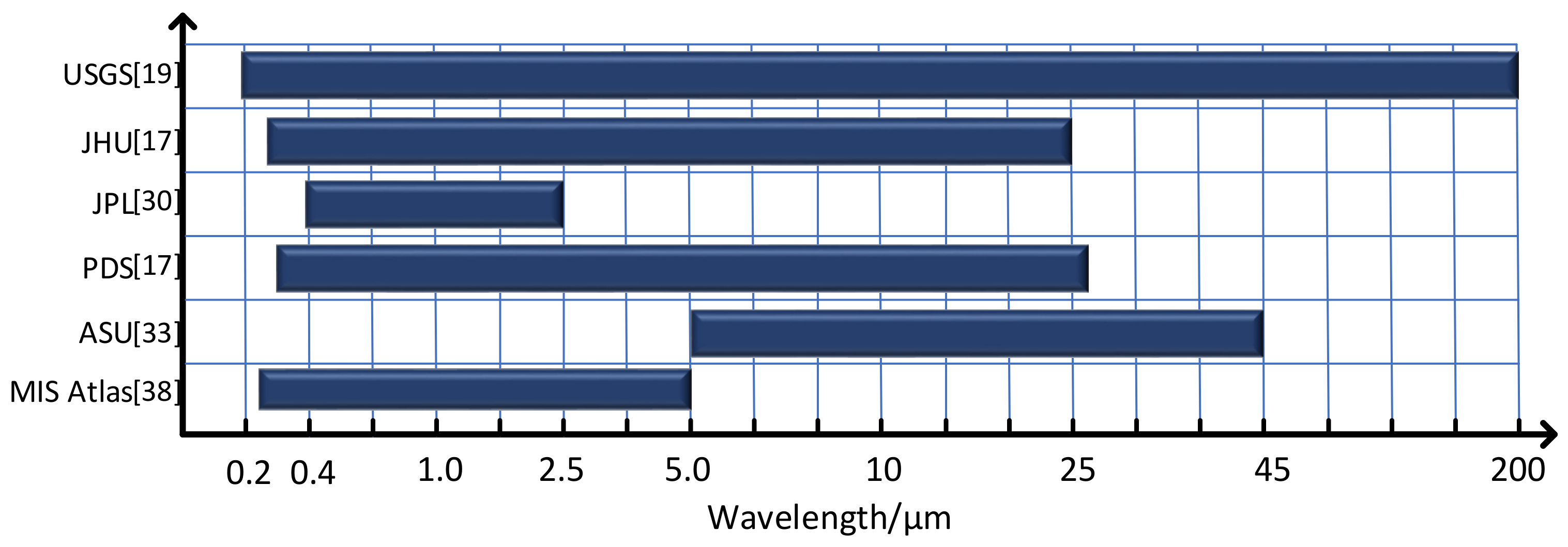
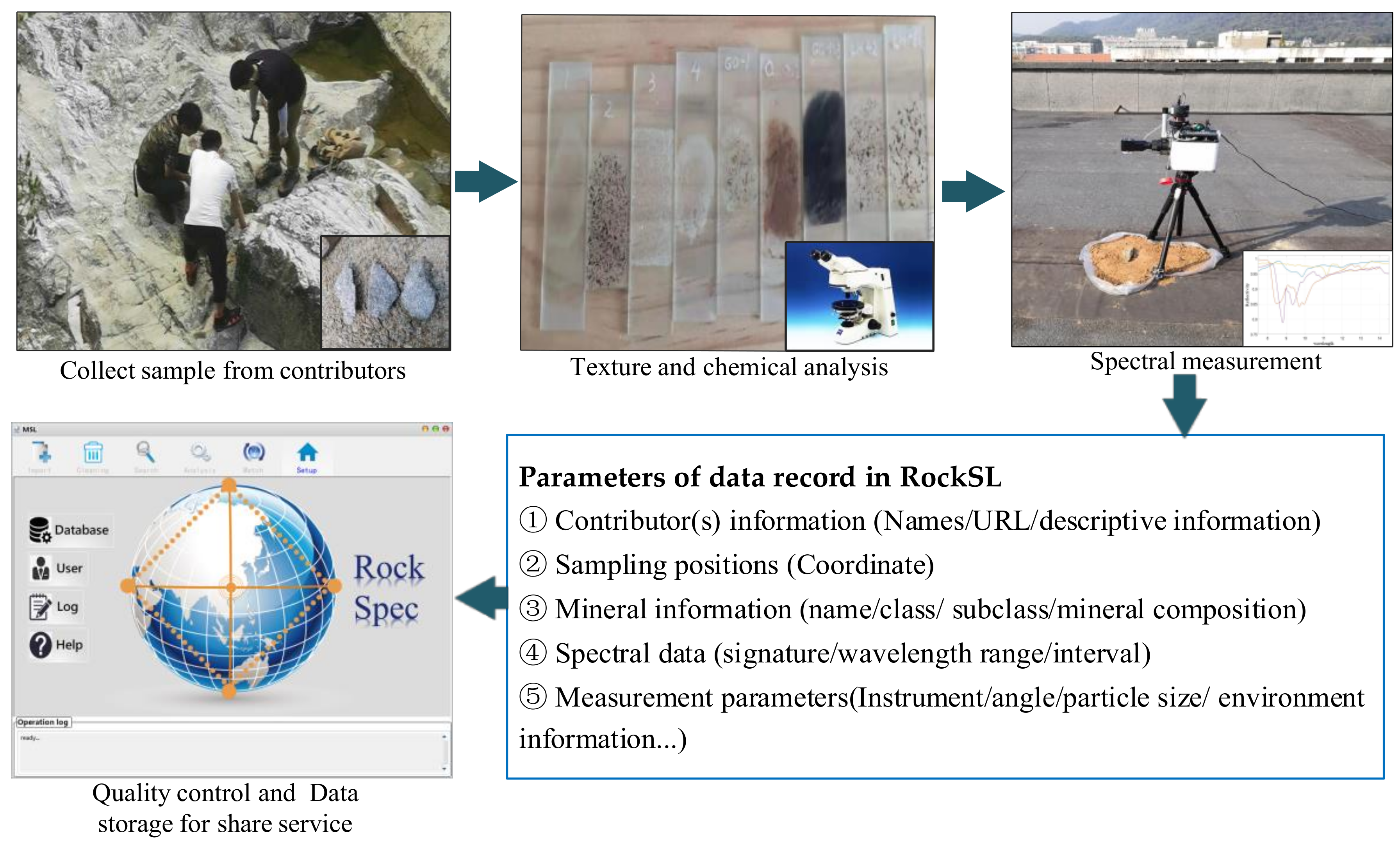

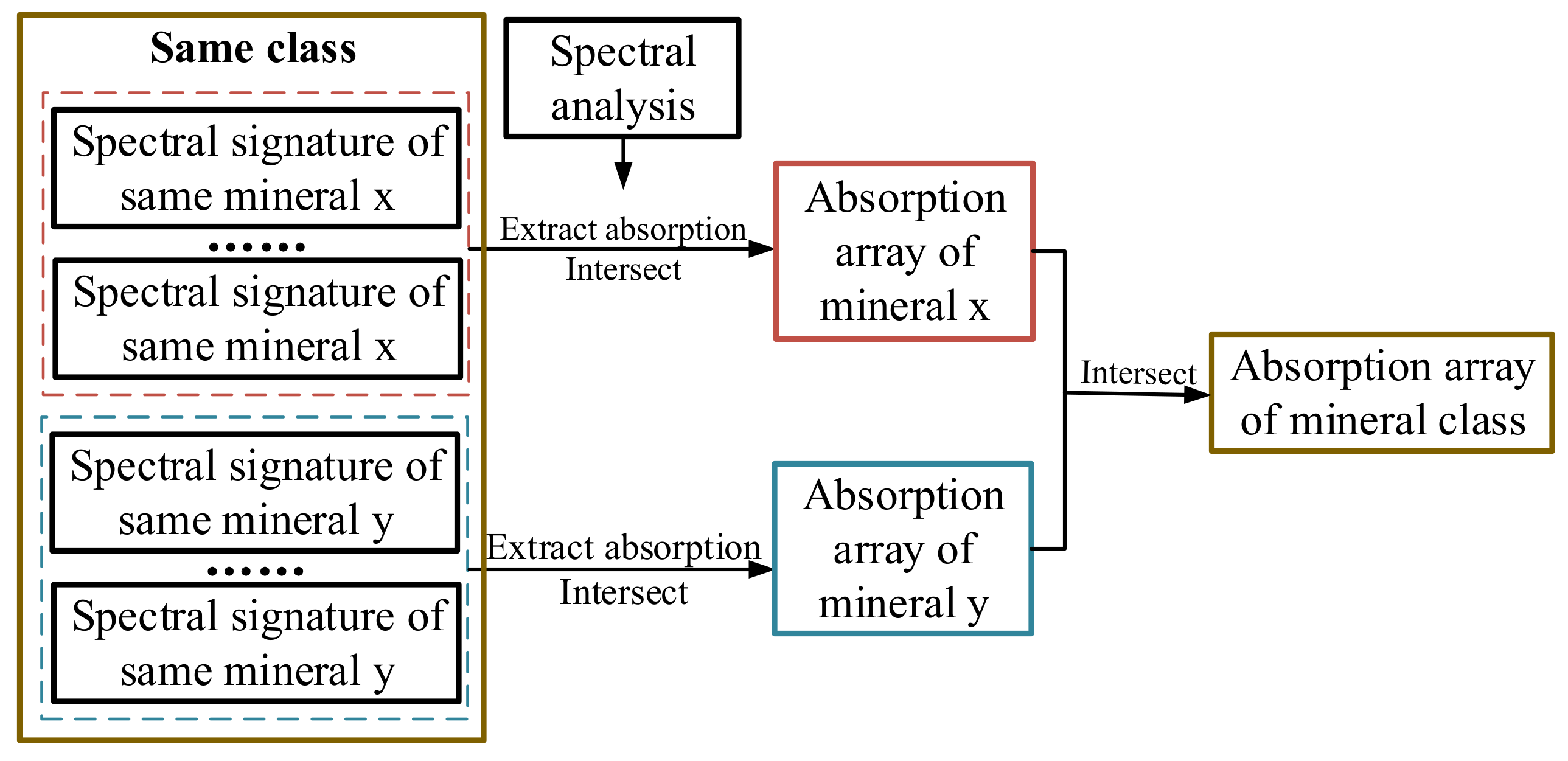
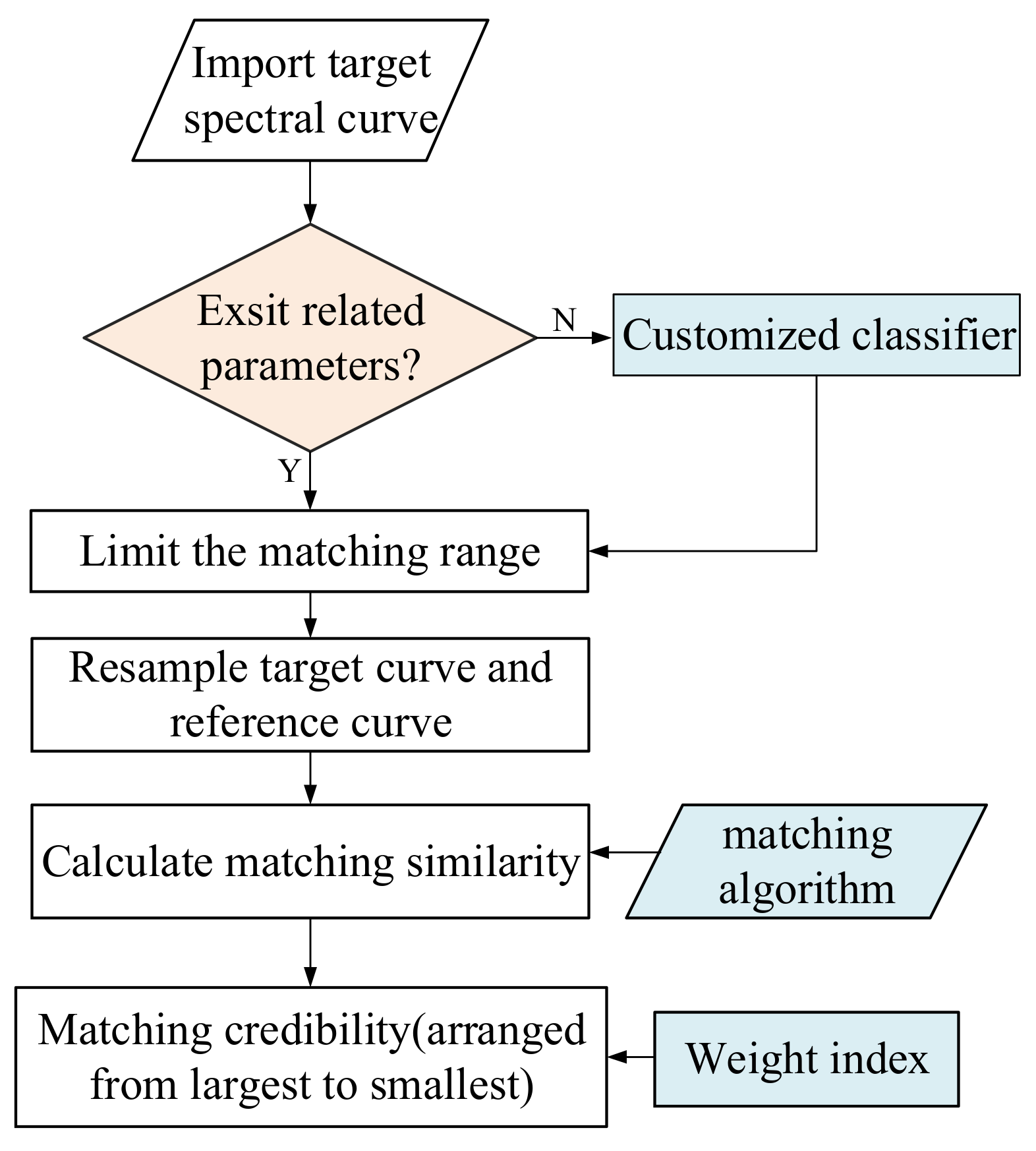


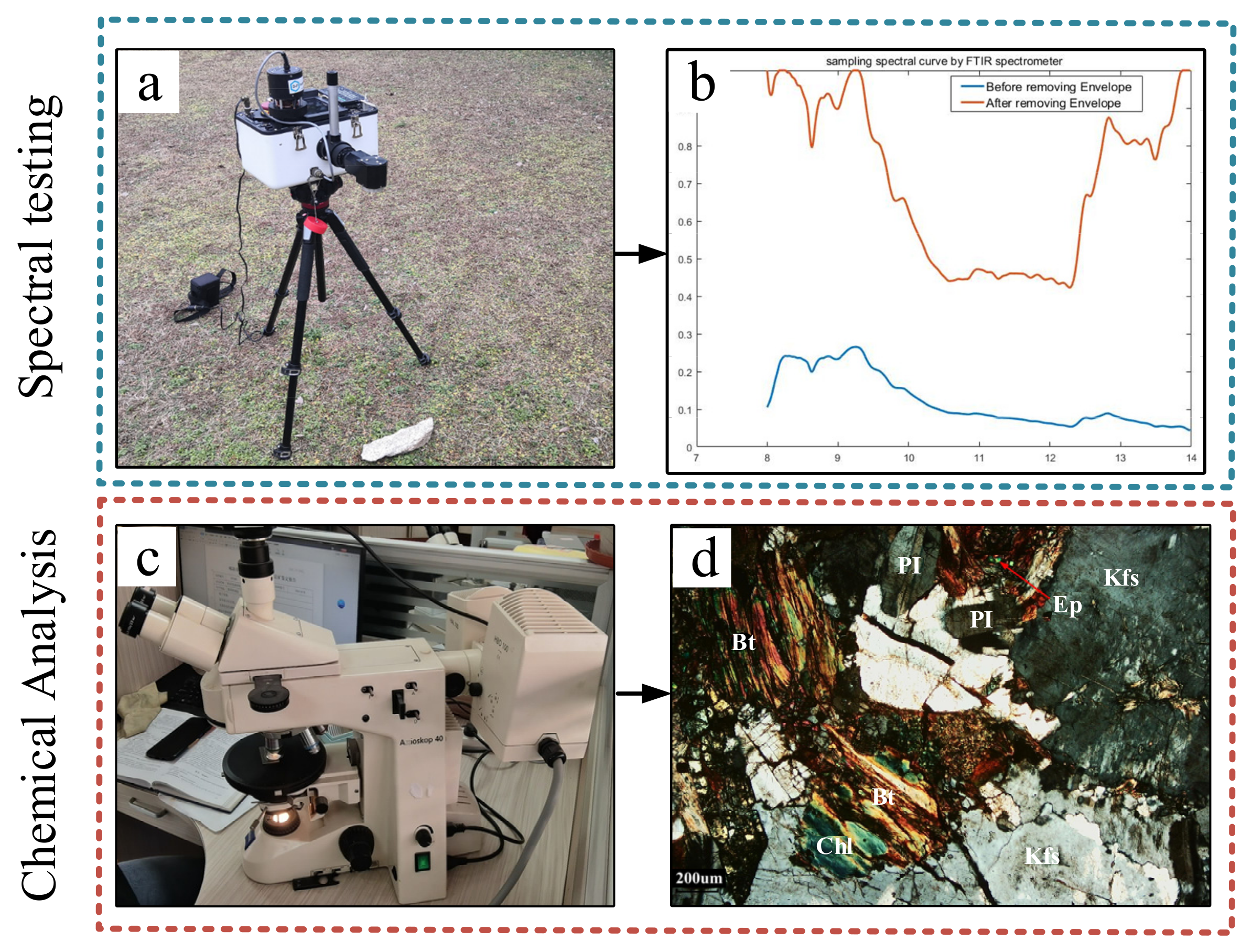

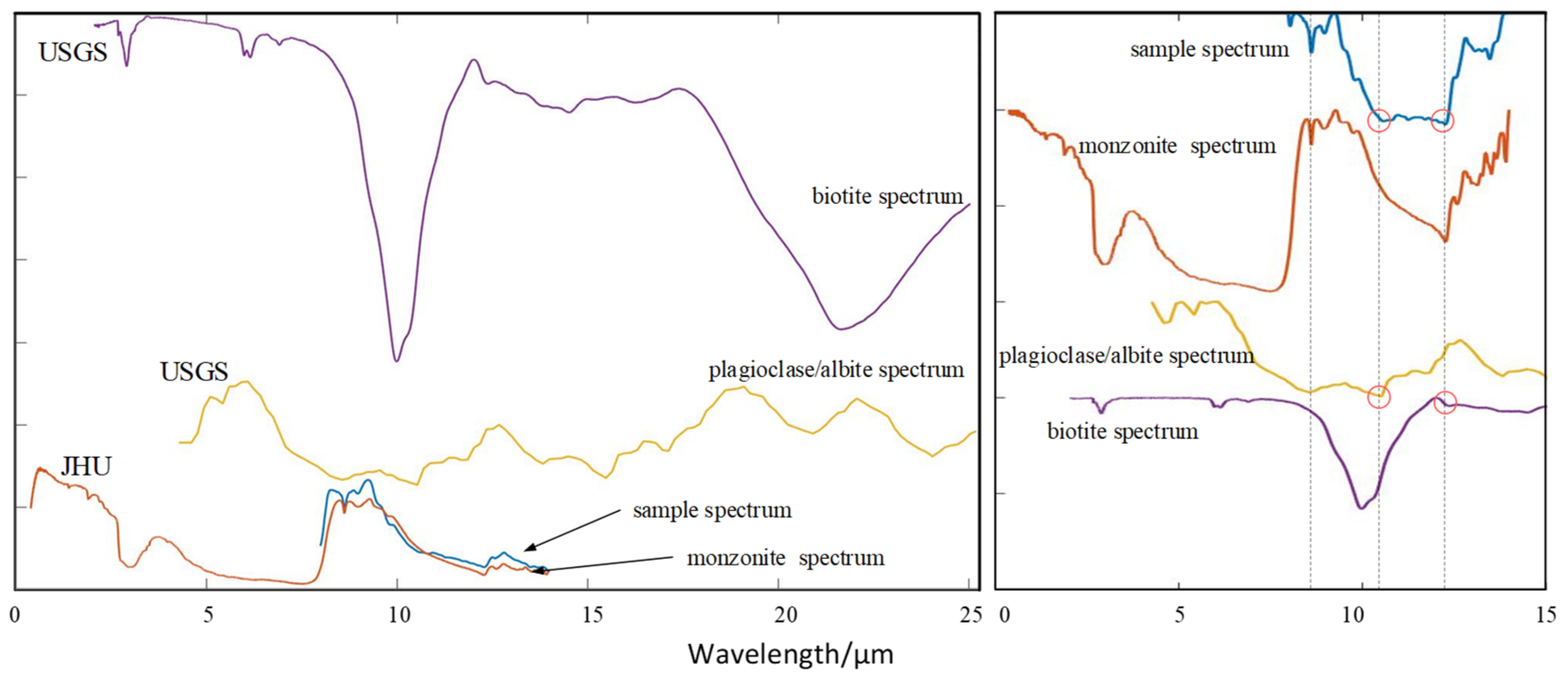
| Spectral Library | Wavelength Range | Particle Size | Instrument | Storage Format | Spectra Amount | Data Resource |
|---|---|---|---|---|---|---|
| USGS [19] | 0.2–200 μm | μm level | Beckman 5270, ASD, Nicolet, AVIRIS etc. | text files and related information | 2468 | Laboratory and Field and Airborne |
| JPL [30] | 0.4–2.5 μm | <45 μm, 45–125 μm, 125–500 μm | Beckman UV5240 | Spectrum.txt and ancillary.txt | 3104 | Laboratory |
| JHU [17] | 0.4–14 μm 2.08–25 μm | μm level | / | Spectrum.txt and ancillary.txt | 3104 | Laboratory |
| PDS [35] | 0.3–26.0 μm | μm level | Tab file | 826 | Laboratory | |
| ASU [33] | 5.0–45 μm | 710–1000 μm | Beckman, ASD, | HDF/text file | 150 | Laboratory |
| MIS Atlas [38] | 0.25–5.0 μm | / | / | images | 583 | Laboratory |
Publisher’s Note: MDPI stays neutral with regard to jurisdictional claims in published maps and institutional affiliations. |
© 2022 by the authors. Licensee MDPI, Basel, Switzerland. This article is an open access article distributed under the terms and conditions of the Creative Commons Attribution (CC BY) license (https://creativecommons.org/licenses/by/4.0/).
Share and Cite
Xie, B.; Wu, L.; Mao, W.; Zhou, S.; Liu, S. An Open Integrated Rock Spectral Library (RockSL) for a Global Sharing and Matching Service. Minerals 2022, 12, 118. https://doi.org/10.3390/min12020118
Xie B, Wu L, Mao W, Zhou S, Liu S. An Open Integrated Rock Spectral Library (RockSL) for a Global Sharing and Matching Service. Minerals. 2022; 12(2):118. https://doi.org/10.3390/min12020118
Chicago/Turabian StyleXie, Busheng, Lixin Wu, Wenfei Mao, Shengyu Zhou, and Shanjun Liu. 2022. "An Open Integrated Rock Spectral Library (RockSL) for a Global Sharing and Matching Service" Minerals 12, no. 2: 118. https://doi.org/10.3390/min12020118






